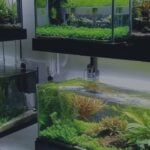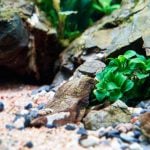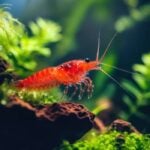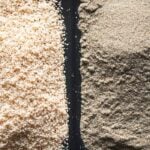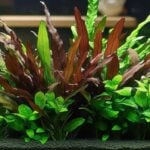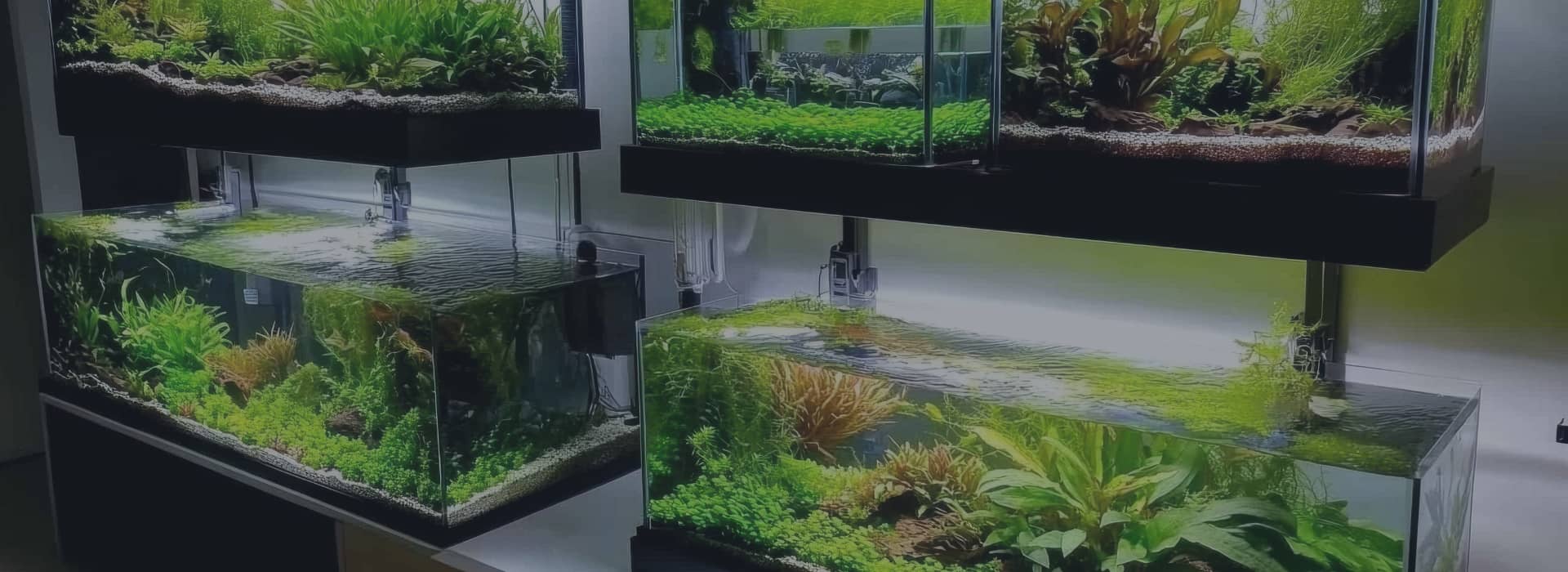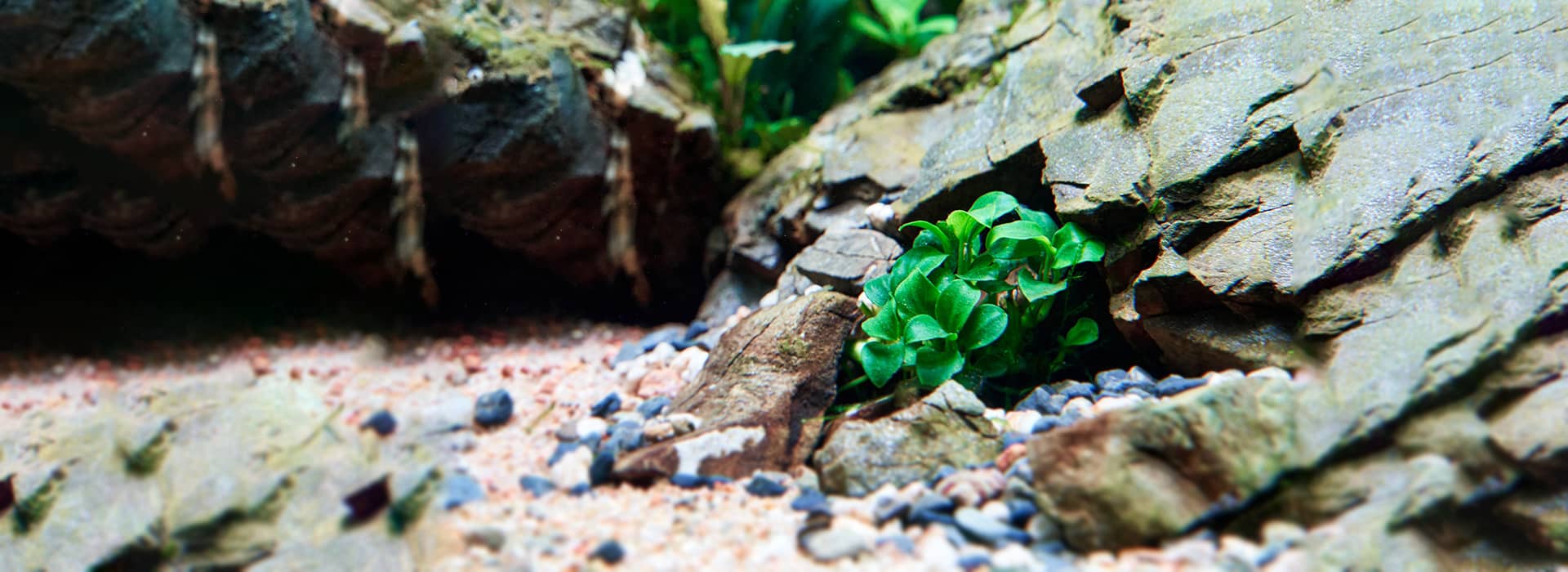Red, pink, and purple aquarium plants are not just visually stunning; they add a depth of colour and contrast to any aquascape. These vibrant plants can range from deep burgundy to bright cherry reds, offering a palette of colours that can make any aquarium stand out.
Here’s a list of some popular red aquarium plants for your planted aquarium.
1. Alternanthera reineckii
Also known as the water hedge, this aquatic plant is native to South America and grows in marshes, stream banks, and ponds.
This vibrant aquatic plant can transform any freshwater aquarium into a lush, colourful landscape. It is favoured for its striking red, purple, and pink foliage that adds depth and contrast to an aquascape
Lighting
Alternanthera reineckii thrives under moderate to high lighting conditions. Adequate lighting is crucial for the plant to develop its signature red colouration. If the lighting is insufficient, the leaves may turn green and lose their vibrancy.
Water Parameters
The optimal pH level for this plant is between 6.0 and 7.0, with a general hardness (GH) of 2 to 12. It prefers warmer water temperatures, ideally between 22 – 28°C (71 – 82°F).
Propagation and Maintenance
Propagation is relatively straightforward – simply cut the stem and replant the trimmings into the substrate. This will encourage bushier growth and allow you to spread the beauty of this plant throughout your aquascape.
This plant absorbs a lot of nutrients from the substrate, so it’s important to ensure that the substrate is rich in nutrients to support the plant’s health and vibrant colouration.
CO2 supplementation can significantly benefit this plant, promoting lush growth and intense colour.
When planting Alternanthera Reineckii, it’s best to place it in the midground or background of your aquarium, depending on the size of the plant and the layout of your tank.
It’s compatible with a wide range of tank mates, but it’s always a good idea to quarantine new plants to prevent the introduction of pests into your aquarium.
2. Ludwigia repens
Also known as creeping primrose willow, this plant can grow partially or fully submerged in water. It is native to North and Central America and naturalised in other areas.
When underwater, the stems and leaves can vary in colour from dark green to brownish red or deep red. The flowers lack stalks and have four yellow petals. They are located at the base of leaf pairs. The leaves are shiny and oval and grow in opposite pairs.
Like all live plants, Ludwigia repens contributes to the oxygenation of the water, which is beneficial for all tank inhabitants. It also helps improve water quality by absorbing excess nutrients and harmful substances like ammonia and nitrates.
The dense foliage provides shelter and breeding grounds for fish and invertebrates, creating a more natural and comfortable environment.
To ensure the health and growth of Ludwigia repens, provide an environment that closely mimics its natural habitat. Here are the key factors to consider:
Lighting
Ludwigia repens requires moderate to high lighting to maintain its vivid colouration. Insufficient lighting may cause the plant to become leggy and lose its rich hues.
Water Parameters
The ideal temperature range for Ludwigia repens is between 20°C to 28°C (68°F to 82°F). This plant can tolerate a wide range of temperatures but thrives best within this range. A pH range of 6.0 to 8.0 is suitable for this plant, allowing it to grow in slightly acidic to slightly alkaline water conditions.
Propagation and Maintenance
Cuttings can be planted directly into a nutrient-rich substrate. With proper care, they will quickly take root and grow.
Regular pruning is necessary to maintain the desired shape and size and encourage bushier growth. Trimming the top shoots also helps propagate new plants, as these cuttings can be replanted.
3. Rotala rotundifolia
Rotala rotundifolia, commonly known as Dwarf Rotala or Round-leaf toothcup, is a popular aquatic plant in the aquarium hobby for its vibrant green and reddish colouration and ease of care.
Native to Southeast Asia, this fast-growing stem plant thrives in a wide range of water parameters and is often used to decorate the mid-ground and background of planted tanks.
To ensure the best growth for your Rotala rotundifolia, aim for the following conditions in your aquarium:
Lighting
Medium to high lighting is ideal for promoting vibrant colours and healthy growth.
Water Parameters
A pH range of 6.0 to 8.0, with a general hardness (GH) of 2 to 12, and a temperature between 20°C to 28°C (68°F to 82°F) will provide a comfortable environment for the plant.
Propagation and maintenance
To propagate, cut the top of a healthy stem and replant it into the substrate. The original stem will often produce new side shoots as well. Place individual stems into the substrate, allowing enough space between them for light to reach the lower leaves and enabling the plant to bush out properly.
Regular pruning will keep your Rotala rotundifolia looking its best. Trimming encourages bushier growth and prevents the lower leaves from being shaded out.
While not strictly necessary, CO2 supplementation can boost growth and encourage the red hues that Rotala rotundifolia is known for.
4. Cryptocoryne wendtii ‘Red’
Cryptocoryne wendtii, commonly known as Wendt’s water trumpet, is a beloved freshwater aquarium plant that offers a lush backdrop or accent to any aquatic setup.
Originating from the tropical waters of Sri Lanka, this plant has gained popularity among aquarists for its adaptability and the aesthetic appeal it brings to an aquarium.
It thrives in a variety of conditions, making it suitable for both novice and experienced aquarium enthusiasts.
Lighting
While it can adapt to various lighting conditions, moderate lighting is ideal for promoting vibrant leaf colouration and growth.
Water Parameters
The plant prefers a temperature range of 72-82°F and a pH level between 6.0 to 8.0.
Propagation and maintenance
To propagate, divide the plant at the rhizome and replant the cuttings. Plant the plants in clusters to create a natural, dense appearance.
When first introduced to your tank, it may experience ‘melting’, but with stable conditions, it will recover and flourish.
Perform water changes to maintain water quality and trim any yellow or decaying leaves to encourage new growth.
Fertilisation can benefit the plant, but it’s not always necessary, especially if the substrate is nutrient-rich.
5. Pogostemon stellatus
Pogostemon stellatus, commonly known as the Starry Watermint, is a fascinating aquatic plant that has captured the attention of aquarium enthusiasts worldwide.
Its unique appearance, characterised by needle-like leaves and a vibrant colour palette, makes it a favourite among those looking to add a touch of elegance and complexity to their aquatic setups.
Originating from Southeast Asia and Australia, Pogostemon stellatus thrives in a variety of water conditions
Lighting
It shows its best growth and colouration when provided with a well-lit environment. Moderate to high lighting is recommended to fully express the plant’s potential.
Water Parameters
The ideal temperature range for this species is 22-28°C (72-82°F), which suits most tropical aquariums. Pogostemon stellatus prefers soft to moderately hard water with PH between 6.5 and 7.5 for optimal health.
Propagation and Maintenance
Propagation can be achieved through head cuttings, which should be replanted in the substrate to develop new roots. This method allows for easy cultivation and expansion of the plant within the aquarium.
Regular dosing with a quality liquid fertiliser will ensure that the plant receives all the necessary nutrients for robust growth. CO2 supplementation is not strictly required but can contribute to even more vigorous growth and intense colouration.
Aquarists should be aware of the potential for melting and nutrient deficiencies, which can occur if the plant’s requirements are not met. Regular trimming and maintenance will help prevent these issues and encourage a bushy, lush growth pattern.
6. Ammania senegalensis
Ammania senegalensis, commonly known as Senegal Ammania or Red Ammania, is a striking aquatic plant that can add a splash of vibrant colour to freshwater aquariums.
Native to West Africa, this plant is appreciated for its slender stems and bright red to orange leaves, which can create a stunning visual contrast against the green hues of other aquatic plants.
Lighting Requirements
Ammania senegalensis thrives under moderate to high lighting conditions. Adequate lighting is crucial for maintaining the plant’s vivid colour; insufficient light can cause the leaves to turn a dark brown. To achieve the best growth and colouration, provide at least 3 to 4 watts per gallon using full-spectrum bulbs.
Water Parameters
Ammania senegalensis thrive in a temperature range of 22 – 26°C (72 – 79°F) and a water pH of 6.5 – 7.5.
Propagation and maintenance
To propagate, take cuttings from a healthy plant and ensure that each cutting is at least 10 inches long and has several leaves. Plant the cuttings into the substrate, spacing them out to allow room for growth. Over time, the cuttings will develop roots and new shoots, which can then be separated to create new plants.
The plant absorbs nutrients from both the water column and the substrate, so it’s beneficial to use a substrate that is rich in iron and other essential minerals. Additionally, periodic dosing of liquid fertilizers and CO2 supplementation can promote robust growth and enhance the red tones of the leaves.
Frequently Asked Questions
Why are my red plants turning green?
This is often due to insufficient lighting. Red plants need more light to produce the pigments that give them their colour.
How often should I trim red aquarium plants?
The trimming frequency for red aquarium plants varies depending on the growth rate of the specific species. Fast-growing plants like Ludwigia Natans ‘Super Red’ may require weekly trimming, while slower-growing species might only need it monthly. Regular trimming helps maintain the desired shape and encourages bushier growth.
What lighting is best for red aquarium plants?
Red aquarium plants typically require medium to high lighting to maintain their vibrant colour. LED lights with full-spectrum capabilities are often recommended to provide the necessary light intensity and spectrum.
How can I enhance the red colouration of my aquarium plants?
To enhance the red colouration, provide your plants with adequate lighting and a nutrient-rich substrate, and consider CO2 supplementation. Adjusting these factors can help increase the production of red pigments in the plants.
Red Aquarium Plants: An Aquascaper’s Dream
Red aquarium plants can transform an ordinary aquascape into an extraordinary underwater garden.
When selecting plants for your aquarium, consider the lighting, substrate, and nutrient requirements of each species to ensure they thrive in your specific setup.
Additionally, be mindful of the growth patterns and eventual size of the plants to maintain a balanced and harmonious aquascape.
With the right combination of colourful aquatic plants, you can create a stunning underwater garden that will be a joy to observe and a healthy environment for your aquatic pets.
Remember, patience and consistency are key to maintaining the lush, vivid hues of your red aquatic plants.
